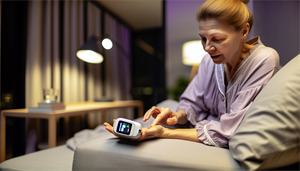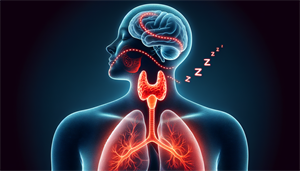If you’re lying awake at night concerned about oxygen levels, knowing “what are normal oxygen levels during sleep” can provide peace of mind. The normal range during sleep is between 95% to 100% saturation. Deviating from this range can be important health-wise.
This article will help you understand what these numbers mean, the various factors that influence them, and when a healthcare provider should be consulted to ensure your nightly oxygen levels support your health.
Key Takeaways
-
Typical blood oxygen levels during sleep usually fall between 95% to 100%, with natural dips that don’t commonly warrant concern unless levels drop below 92%, in which case medical advice is recommended.
-
Pulse oximeters are widely used to monitor blood oxygen levels during sleep; however, professional evaluation is advised as over-the-counter devices may lack comprehensive testing.
-
Sleep apnea is a serious disorder that causes reduced oxygen levels due to interrupted breathing, necessitating medical devices like CPAP or potential lifestyle changes to maintain normal oxygen saturation.
Deciphering Normal Oxygen Saturation Levels in Slumber

Think of your body as an intricate city, bustling with activity, and the red blood cells as diligent delivery trucks. They’re tasked with transporting precious cargo - oxygen - from the lungs to the remote corners of your body, ensuring the smooth functioning of organs and tissues. The binding of oxygen to hemoglobin, a protein in red blood cells, facilitates this essential transportation. The biconcave disc shape of red blood cells and their increased surface area-to-volume ratio contribute to the efficient exchange of oxygen, allowing them to navigate through different blood vessels like expert drivers on a busy highway.
Shifting our attention to a person’s blood oxygen level, particularly the typical blood oxygen levels during sleep, on an average night, these usually range from 95% to 100%. However, you might observe a slight dip as a result of natural fluctuations like periods of slow or shallow breathing and short pauses in breaths. So, when does the alarm bell ring? A blood oxygen level lower than 92% should be a cause for concern. If it falls below 88%, immediate medical attention is required. It’s a delicate balance, isn’t it?
The Role of Red Blood Cells in Oxygen Transport
Examining the role of red blood cells further, we discover their significant contribution to our bodies. When oxygen binds to the iron in the heme group of hemoglobin, it forms oxyhemoglobin, a complex that facilitates efficient oxygen transportation by the red blood cells. This intricate process ensures that every cell in your body gets its fair share of oxygen.
Yet, not everything goes according to plan always. Just as traffic jams can slow down delivery trucks, several factors can lead to a decrease in blood oxygen levels during sleep. Conditions such as:
-
sleep apnea
-
sleep-related hypoventilation
-
certain medications
-
alterations in breathing patterns across different sleep stages
may contribute to this decrease. This is a complicated interaction of factors that plays out each night as you fall asleep.
Variations in Oxygen Levels: What's Considered Normal?
What about the shifts in oxygen levels throughout various sleep stages? Interestingly, during REM sleep, oxygen saturation typically decreases compared to NREM sleep. It’s as if your body is conducting a symphony, each stage of sleep playing its distinctive note.
However, these minor fluctuations should not set off alarm bells. Several factors can lead to these changes, such as:
-
Sleep apnea
-
Lung disease
-
Respiratory disorders
-
Heart failure
-
Obesity
Understanding these fluctuations is key to comprehending the overall picture of oxygen saturation levels during sleep.
Keep in mind, a minor detour doesn’t imply you’re off track; it’s simply another aspect of the journey!
The Science of Measuring Blood Oxygen During Sleep

Having acknowledged the importance of oxygen levels during sleep, the question arises - how do we measure blood oxygen levels? Cue the pulse oximeter, a small, painless clip placed on a person’s fingertip that diligently records blood oxygen levels over time. It’s the prevailing device utilized in both clinical and home environments to monitor blood oxygen levels during sleep.
While these devices offer helpful insights, their use should align with the guidance of a healthcare expert. Over-the-counter pulse oximeters and smartphone-based devices have not undergone comprehensive testing and should not be relied upon for self-monitoring of health. Much like traversing the seas, a compass can guide you, but it’s always safer to depend on an experienced captain for the voyage!
Home Sleep Test vs. Clinical Assessment
A home sleep test serves as a convenient diagnostic tool that monitors breathing patterns and measures oxygen levels using a finger probe. It’s the equivalent of having a personal health assistant that works while you sleep. However, while the convenience and cost-effectiveness of home sleep tests are appealing, they may not be as accurate as monitored laboratory tests.
In comparison, clinical assessments offer a more comprehensive evaluation of oxygen saturation levels during sleep. This could be likened to the difference between a standard map and an intricately detailed satellite image. While both provide key information, the latter provides a more precise and comprehensive view. Therefore, while home sleep tests can provide valuable initial insights, clinical assessments are invaluable for a more detailed understanding.
Unveiling the Link Between Sleep Apnea and Oxygen Levels

Moving from the domain of healthy sleep, we delve into the realm of sleep disorders, particularly sleep apnea. This common sleep disorder occurs when the muscles in the throat relax and obstruct normal breathing, causing a decrease in oxygen levels during sleep. Just as a blocked road disrupts the smooth flow of traffic, sleep apnea interrupts the steady delivery of oxygen throughout the body.
The severity of sleep apnea is measured by the frequency of breathing interruptions, with severe sleep apnea indicated by 30 or more occurrences per hour, leading to substantial oxygen desaturation. In contrast, mild sleep apnea has fewer interruptions per hour. This can be compared to a city plagued with frequent power outages, causing disruptions to the entire system.
Recognizing Symptoms of Sleep-Related Breathing Disorders
How can one discern if they’re suffering from a sleep related breathing disorder? Signs include:
-
Snoring
-
Gasping or choking during sleep
-
Excessive daytime sleepiness
-
Restless sleep
-
Interrupted breathing
It is as though your body is ringing an alarm bell, signalling possible disruptions in the oxygen delivery system.
Sleep apnea results in irregularities in breathing patterns, including pauses in breathing and a decreased respiratory rate. These lead to symptoms such as loud snoring, daytime sleepiness, and a dry mouth or sore throat upon waking. It’s a wake-up call, signaling that your body needs attention.
Factors That Can Lower Blood Oxygen Levels During Sleep

On this journey, we come across environmental factors that can impact blood oxygen levels. High altitude is one such factor that can decrease blood oxygen levels during sleep. Imagine scaling a mountain; as you ascend, the air becomes thinner, and oxygen levels drop.
Prolonged exposure to high altitudes can lead to negative impacts on:
-
Body weight
-
Muscle structure
-
Exercise capacity
-
Cognitive function
-
Sleep quality
This can be likened to the body’s attempt to adapt to a new environment, making necessary modifications to ensure survival.
High Altitudes and Oxygen Saturation
Elevated locations can cause a reduction in oxygen saturation levels during sleep due to diminished air pressure and decreased oxygen supply, especially at altitudes exceeding 2500 meters. It’s akin to a city experiencing a water shortage; the supply is there, but the pressure is too low to reach all areas effectively.
In response to high altitudes, the human body may increase the production of red blood cells to enhance the supply of oxygen due to the diminished capacity to extract oxygen from the atmosphere. This can be compared to a city ramping up its water delivery trucks to guarantee an adequate supply to all areas.
Effective Treatments to Maintain Normal Oxygen Levels

Much like every problem has a resolution, there exist effective solutions to maintain normal oxygen levels during sleep. For individuals with obstructive sleep apnea or chronic obstructive pulmonary disease, a continuous positive airway pressure (CPAP) device may be prescribed. This device functions like a steady wind, delivering positive air pressure to the airway, preventing its collapse during sleep, and enhancing oxygen levels.
For those with sleep-related hypoxemia, supplemental oxygen may be prescribed to enhance nocturnal oxygen desaturation and prevent the elevation of blood pressure that may occur during episodes of sleep-related hypoxemia. This is akin to bolstering the water supply in a city facing a water shortage, making certain that all regions have access to the vital resource.
Lifestyle Adjustments for Better Oxygen Saturation
Beyond medical interventions, lifestyle adjustments can also improve oxygen saturation levels during sleep. Maintaining a healthy weight has a positive impact on oxygen levels, as excess weight is linked to the severity of oxygen desaturation, which can be exacerbated by sleep apnea. This could be compared to alleviating traffic congestion in a city for the smooth delivery of supplies.
Avoiding alcohol before sleep can also lead to increased arterial blood oxygen saturation and reduce the occurrence of oxygen desaturation during sleep. Additionally, certain sleep positions, such as sleeping on the side, can aid in enhancing oxygen levels during sleep. This is a holistic approach, incorporating multiple strategies to guarantee optimal oxygen saturation during sleep.
Navigating Through Severe Sleep Apnea and Its Risks
After understanding the journey of oxygen through your body during sleep and the influencing factors, we now traverse the realm of severe sleep apnea. This condition is associated with an elevated risk of various life-threatening conditions and accelerated aging throughout the body.
The requirement for a CPAP machine may arise when there is a substantial impact on the individual’s quality of life, leading to symptoms such as fatigue and an increased risk of falling asleep while operating a vehicle. This can be likened to installing traffic signals in a bustling city to maintain smooth and safe traffic flow.
When to Seek Medical Attention for Low Oxygen Levels
Understanding when to seek medical attention for low blood oxygen is crucial. If blood oxygen levels consistently drop below 90% during sleep, it is essential to consult a healthcare professional for proper diagnosis and treatment. Not addressing this can have serious health consequences, such as an increased likelihood of high blood pressure, heart disease, and diabetes. Prioritizing these issues is vital for overall health and well-being.
Healthcare professionals may offer interventions such as continuous positive airways pressure (CPAP) for sleep apnea and supplemental oxygen for those at ongoing risk of hypoxemia during sleep. This is akin to engaging a team of experts to manage a city’s water supply, ensuring equitable distribution to all areas.
Summary
As we reach the end of our journey, it’s time to revisit the key points. We started by exploring the role of red blood cells in oxygen transport and understanding the normal oxygen saturation levels during sleep. We then delved into the methods of measuring blood oxygen levels and the link between sleep apnea and oxygen levels. We learnt about the factors that can lower blood oxygen levels, like high altitudes, and the effective treatments to maintain these levels.
In the realm of sleep, the journey of oxygen is a complex dance of many factors. Understanding this dance is key to maintaining optimal health and wellness. Remember, every breath you take while sleeping is a testament to the intricate, unseen world within you. As you drift off to sleep tonight, may you do so with a newfound appreciation for the intricate journey of oxygen in your body, and may your dreams be as rich and vibrant as the life-giving oxygen coursing through your veins.
Frequently Asked Questions
What is a dangerously low oxygen level while sleeping?
A blood oxygen level below 92% may be a cause for concern, while a level below 88% requires prompt medical attention. It's important to monitor your oxygen levels while sleeping to ensure your health and well-being.
What is a good overnight oxygen level?
A good overnight oxygen level is a mean oxygen saturation of 96%, based on healthy controls. Aim for this level for optimal sleep quality and overall health.
What should your oxygen saturation be on a sleep test?
Your oxygen saturation should ideally be between 96% and 100% during sleep. Any deviation from this range may indicate potential health issues that should be investigated.
Related health topics?
It's important to stay informed about various health topics, including coronavirus disease (COVID-19), reproductive health, air pollution, obesity, mental health, and vaccines. Keeping up with these issues can help you make informed decisions about your health.
What is sleep apnea, and how does it affect oxygen levels during sleep?
Sleep apnea is a sleep disorder that causes decreased oxygen levels during sleep due to the relaxation of throat muscles, which obstruct normal breathing.


